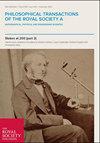In-orbit results from the SNAP-1 nanosatellite and its future potential
Philosophical Transactions of the Royal Society of London. Series A, Mathematical and Physical Sciences
Pub Date : 2003-01-15
DOI:10.1098/rsta.2002.1123
引用次数: 33
Abstract
It is now feasible to construct highly capable ‘nanosatellites’ (i.e. sub–10 kg satellites) to provide cost–effective and rapid–response orbiting test vehicles for advanced space missions and technologies. The UK's first nanosatellite, SNAP–1—designed and built by Surrey Space Centre (SSC) and Surrey Satellite Technology Ltd (SSTL) staff — is an example of such a test vehicle: in this case, built with the primary objective of demonstrating that a sophisticated, fully agile nanosatellite can be constructed rapidly, and at very low cost, using an extension of the modular–COTS–based design philosophy pioneered by SSC for its microsatellites. SNAP–1 was successfully launched into orbit on 28 June 2000 from the Plesetsk Cosmodrome on board a Russian Cosmos rocket. It flew alongside a Russian Cospas–Sarsat satellite called Nadezhda, and an SSTL–built Chinese microsatellite, called Tsinghua–1. The first year of operations has been highly successful, with SNAP–1 becoming the first nanosatellite to have demonstrated full attitude and orbit control, via its miniature momentum–wheel–based attitude control system and its butane–propellant–based propulsion system. This paper reviews the initial results of the SNAP–1 mission.SNAP-1纳米卫星的在轨结果及其未来潜力
现在可以建造高性能的“纳米卫星”(即10公斤以下的卫星),为先进的空间任务和技术提供具有成本效益和快速反应的轨道测试工具。英国的第一颗纳米卫星snap - 1是由萨里航天中心(SSC)和萨里卫星技术有限公司(SSTL)的工作人员设计和建造的,是这种测试飞行器的一个例子:在这种情况下,建造的主要目标是证明一个复杂的、完全敏捷的纳米卫星可以快速建造,并且成本很低,使用SSC为其微卫星开创的基于模块化cots的设计理念的扩展。SNAP-1于2000年6月28日由俄罗斯宇宙号火箭从普列谢茨克航天发射场成功发射进入轨道。它与俄罗斯Cospas-Sarsat卫星“Nadezhda”和sstl制造的中国微卫星“清华一号”一起飞行。第一年的运行非常成功,SNAP-1通过其基于动量轮的微型姿态控制系统和基于丁烷推进剂的推进系统,成为第一颗展示了完全姿态和轨道控制的纳米卫星。本文回顾了SNAP-1任务的初步结果。
本文章由计算机程序翻译,如有差异,请以英文原文为准。
求助全文
约1分钟内获得全文
求助全文
来源期刊
自引率
0.00%
发文量
0

 求助内容:
求助内容: 应助结果提醒方式:
应助结果提醒方式:


